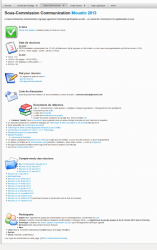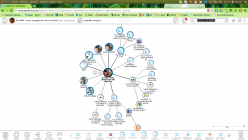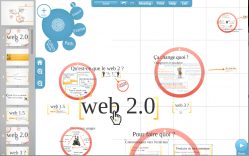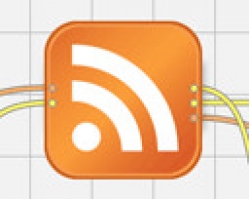
Organising the communication of an event from a distance
Card's author :
Corinne Lamarche - SupAgro Florac
Card's type of licence :
Creative Commons BY-SA
Testimonies :
I can explain an experience relating to distance working that surprised me for its efficiency. I was part of a small group in charge of communication at the 2013 Moustic Meetings that grouped 200 people.
What I think is important is to decide what tools will be used, for what purpose, and how beforehand; it is especially important not to change along the way, or being sure that everyone can master the tool.
How was it done?
At the start I only knew four of the eight people I met at the event. We had participated together in around fifteen distance meetings during five months, using Skype. I wasn't sure it would work at the start; Nevertheless, the result was excellent! I was really surprised at the ability we can have to work at distance from the moment we choose the right tools and people are ready to share and listen. Of course, the skills of one another all contributed, but this was not enough. Collaborative tools helped us a lot.What we created
For this event, a wiki was created with sections for each of the commissions (Co-steering, programming, financing, communication). Exchanges flowed well thanks to posting a kind of spreadsheet on one page with several sections to it:- things to do (summarising the decisions taken at the end of the meetings), which I could refer to, to see what tasks I had to do and, those I didn't need to do and those that depended on available time. At the beginning, these tasks had been assigned to one or two people, but not exclusively; this allowed us to see the progression.
- the days for the meetings agreed beforehand. At first, we discussed everyone's availability (working time) and holidays.
- the link to take notes at the meetings; and an emergency pad if the host server crashed for any reason (this happened to us once).
- the address of the discussion list so that people working in other commissions could communicate with this one.
- reference documents (with a link to each Google doc or to a work tool). It is worthwhile listing the documents that are useful for the commission to make finding them easier than searching through emails. One and a half months before the meeting, many documents were created and an email was sent every time to provide the link to the documents. Sometimes the subject of the message was not clear and this posed some problems when it came to finding this information. So I decided to collect all the links and place them on this page describing the contents. It is also important not to create several spreadsheets but rather several tabs on the same spreadsheet
- the minutes of the meetings. Five days before the meetings, I sent an email reminding the date and time of the meeting, a link to the pad containing all the information and meeting agenda asking if anyone wanted to add more points to the agenda; sometimes I also wrote down some questions and got answers back the same day. One week before the meeting, I would read the minutes of other sub-commissions and if there was anything that should be told the group I would write this down also. After the meeting, the facilitator or someone else would post the meeting minutes on the wiki page (with a format, hyperlinks, readable) and would send the link to the other members, (also so those who could not attend the meeting would be informed) and with a reminder for the next meeting
- the list of participants with the names, surnames and roles of the participants in the sub-commission
What I think is important is to decide what tools will be used, for what purpose, and how beforehand; it is especially important not to change along the way, or being sure that everyone can master the tool.
Internet link :
http://moustic.info/2013/wakka.php?wiki=ComMunication


